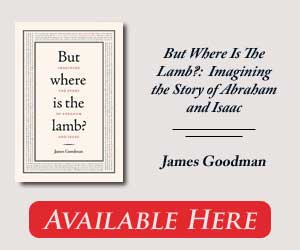But Where Is the Lamb?: Imagining the Story of Abraham and Isaac, By James Goodman, Schocken, 306 pp., $25
The story of the Binding of Isaac in Genesis 22 is a superlatively important and deeply troubling part of scripture. God tests Abraham by ordering the sacrifice of his only legitimate son, Isaac, miraculously born in his wife Sarah’s old age. Without disputing God or saying a word to Sarah, he sets off with Isaac for a distant mountain, which they ascend alone, leaving their two attendants and their donkey at its base. Isaac, carrying a bundle of wood for incinerating the sacrifice according to custom, notices that a lamb is missing, but Abraham assures him that God will provide one.
At the top of the mountain, as the patriarch raises his knife over the bound, apparently unprotesting boy, an angel’s voice delivers the divine reprieve: Abraham’s willingness to sacrifice his own son has undone God’s command to kill him. A ram appears as a substitute offering, and Abraham receives a renewed blessing, with the Lord swearing to provide him with innumerable offspring, a source of blessing in turn for “all the nations of the earth.” This future glory granted on such bizarre terms—the heir laid on the altar to ensure descendants—makes the story prime evidence of the Bible’s jagged composition and strange ideological prehistory. In a final chilling touch, Abraham returns alone to his servants, and the three of them proceed home without Isaac being mentioned: another ending might have been quite different.
No wonder that commentators, from the rabbis of antiquity to modern, secular Israeli poets, have not confined themselves to commentary—which itself has ranged widely—but have often elaborated or even rewritten the story. In some versions, a God who needed to be seen as flawlessly merciful and just abstracted Isaac bodily into heaven and returned him later. Other authors questioned how Sarah could not know and changed the plot accordingly. Some modern retellings of the Binding of Isaac protest the cruelty of patriarchy, superstition, and nationalism, or meditate poignantly on the Holocaust.
The story helped shape the development of the three religions “of the Book.” Though hardly a straightforward cautionary tale, the Binding of Isaac must have something to do with Judaism’s eschewing of human sacrifice, which continued among Israel’s neighbors long afterward. Much later, the story was a vehicle for Jewish mysticism, as in the medieval sage Rashi’s imagined interruptions of God’s command by the baffled Abraham, and God’s withholding of immediate explanations. Here, clearly, was a proof of ineffable providence that greatly appealed to the Diaspora amid its trials.
Because the Arabs claimed descent from Abraham’s older son Ishmael, Muslims took a keen interest in the patriarch and found in the Binding of Isaac support for their central tenet, islam, or submission to God’s will. But the story’s most momentous influence was on Christianity, as the crucial means by which Paul of Tarsus worked out his doctrine of salvation. In Scripture and Tradition in Judaism (1961) and other works, religion scholar Geza Vermes persuasively argues that the sacrifice of a son is a direct overlay from this passage onto Christian theology: “[The God] who did not withhold his own son but gave him up for all of us, will he not also give us everything else?”(Romans 8: 32).
 Like Abraham, this line of thinking goes, God was willing to put his own son to death, but unlike Abraham, God actually did it—even making an immortal being mortal to render this possible. And this new sacrifice, as subsequent Christian thinkers explained, instead of threatening innocent human life through a barbaric ritual, had the transcendent and eternal purpose of saving degraded mankind from death. This idea of metaphysical progress lavishly fed the doctrine of “supersessionism,” which holds that Christianity does not build on Judaism but cancels it out. Supersessionism has in this way been a powerful vehicle for anti-Semitism.
Like Abraham, this line of thinking goes, God was willing to put his own son to death, but unlike Abraham, God actually did it—even making an immortal being mortal to render this possible. And this new sacrifice, as subsequent Christian thinkers explained, instead of threatening innocent human life through a barbaric ritual, had the transcendent and eternal purpose of saving degraded mankind from death. This idea of metaphysical progress lavishly fed the doctrine of “supersessionism,” which holds that Christianity does not build on Judaism but cancels it out. Supersessionism has in this way been a powerful vehicle for anti-Semitism.
This seems at first to be just the right scriptural passage for a celebrated historian like James Goodman to follow in its reception. His diligence and passion are certainly not wanting, but they may in fact be excessive for dealing with this topic, around which the research material is for practical purposes infinite, as are the grounds for puzzlement, outrage, and smugness. For all of the glinting details and moving scenes Goodman presents, I have to agree with his Talmud-studying neighbor, who was privy to the book’s progress (as Goodman mentions, among many other diaristic digressions), that personalization of the material and trendy interpretations of it are serious problems in its exposition. Readers without specialized training are likely to get lost in Goodman’s idiosyncratic approach, which offers little that might help them make up their own minds.

